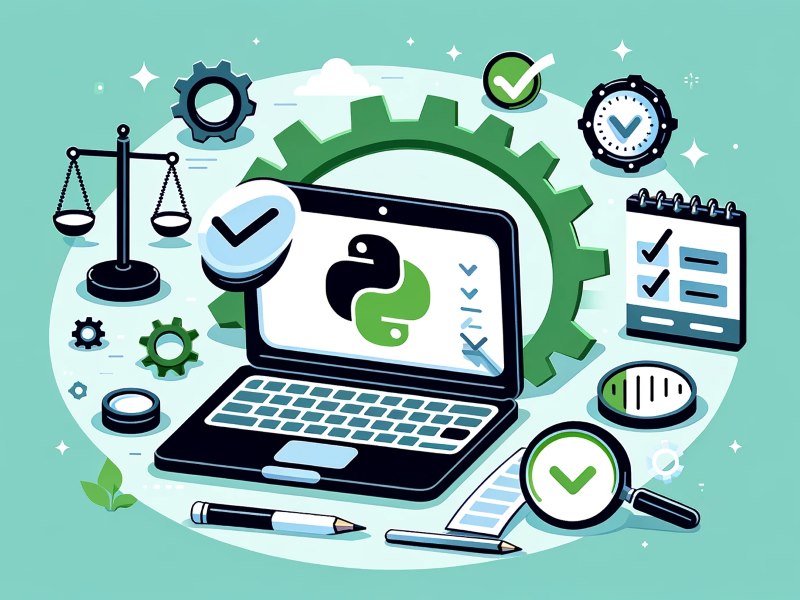Parameters to Consider While Choosing the Right Django Package or Library

Django excels in web development and has become a universal choice. However, the right selection of Django packages and libraries is what guides Django development, which is where the role of evaluating package selection parameters becomes decisive.
Web development using Python is on the rise, and one thing that comes next in its discussion is Django. Known for its versatility and efficiency, the package offers exceptional features and is widely used in web development.
Django offers an extensive array of libraries and packages, each crafted to amplify the capabilities of your web app, and allows developers to implement it across diverse scenarios. However, as choosing top Django packages and libraries is imperative, the process of finding the best amongst the best is fraught with technical complexities.
One of the most used Python frameworks, Django offers some well known packages and libraries such as Django REST framework, Django Tenants, and Django Admin that are commonly used in web development. However, they do not even scratch the surface, as the peculiar requirements of projects often make developers go beyond these common names.
To simplify your decision-making process so that you make the most of Django’s offerings, we bring 12 important parameters to choosing a Django package or library. If you are keen on utilizing Django to its fullest potential, then you must take notice of each of these parameters for your Django development project without fail.
What is a Django package or library?
A Django package is a collection of pre-written code modules or libraries that support effective web development. Django packages provide ready-to-use features and functionalities for common tasks in web development. Examples include authentication or form handling. They save time and effort as they assist developers in integrating powerful features into their Django projects.
What are the parameters to consider when selecting Django package libraries?
As you embark on your Django development project, the choice of package libraries holds immense significance. Our experienced Django developers at Finoit unravel the parameters for selecting from the cream of the crop among Django packages. We’ll delve into many capabilities such as Django import export and Django debug toolbar, which is just the tip of the iceberg!
What does it do and why does it matter?
Functionality is a crucial parameter when selecting Django packages and libraries because it directly impacts the effectiveness and efficiency of a Django project. Django packages extend the framework’s capabilities, offering pre-built solutions for common tasks in web development. When you assess functionality, you ensure that the chosen package aligns with the Django application’s requirements and objectives.
You must start by evaluating functionality which typically involves understanding the specific features and tools a package provides. Here, you will examine its sample code and review functionality offered by senior developers. For instance, if a Django project requires user authentication, evaluating a package’s functionality would involve checking if it offers robust authentication mechanisms, password reset functionality, and support for various authentication backends.
How well does it adjust?
When evaluating a package or library for Django development, assessing its compatibility is highly important for seamless integration into a Django application. Compatibility refers to how well a package aligns with the Django version and other dependencies in a given development environment. Ignoring compatibility can lead to conflicts, and severely impede the smooth functioning of the Django application.
To begin, it is imperative to verify whether the package supports the specific Django version utilized in the development environment. The information can usually be found in the package documentation or release notes. A compatible package ensures that it leverages the features and functionalities provided by the Django version, and thereby optimizes performance and minimizes potential issues.
Also important is to investigate potential conflicts with other packages. Some packages may not harmonize well with certain combinations of dependencies, which may lead to errors or unexpected behavior during the functioning of the application. As a result, a diligent evaluation of compatibility becomes essential for preemptively identifying and mitigating such conflicts.
How well is it Documented?
You can analyze a package or library only by perusing its documentation, which offers comprehensive detail and serves as accompanying instructional material. Clear and detailed documentation includes explanations, practical usage examples, and API references. It serves as an interface between developers and the package, guiding developers on effectively integrating and utilizing it in a project. A package’s documentation, therefore, is central to any Django development process.
Documentation saves significant time and effort that would otherwise be spent on deciphering the package’s intricacies through trial and error. Detailed documentation always demonstrates the suitability of the package, and lets developers draw comparisons across similar packages.
In assessing documentation, it’s crucial to look for specific elements. Read and understand the package’s purpose and functionality. Usage examples illustrate practical applications and will aid Django developers in applying the package effectively. Additionally, API references are indispensable for more advanced users, offering detailed insights into the package’s inner workings. Lastly, but importantly, the document provides a valuable resource for troubleshooting and extending functionality in the future.
Is support there for you?
When evaluating the best Django libraries and packages, one crucial parameter is the maturity of the community. A well-developed community is an indication of the package or library’s vast use and its standing as a tool for sustainable Django development.
The basic step is examining the size and activity of the package’s community. An active community is characterized by regular updates, active discussions, and a substantial number of contributors. For instance, Django REST Framework (DRF) has a significant development community with a large number of contributors.
A community reflects a collective effort towards refining and enhancing the package, which directly benefits its users. With a strong community, developers can rely on timely support, prompt bug fixes, and the introduction of new features, all of which are instrumental in maintaining a robust and effective development process.
The Django community also provides a feedback loop for the package’s maintainers, and this constant flow of ideas and critiques helps in refining the package’s interface and functionality. The package, as a result, stays aligned with the evolving needs of the developer community. Community support is thus a reflection of the continuous improvement and evolution of the package.
What are its Dependencies?
Django packages exhibit dependencies on external components, frameworks, libraries, or platforms. Understanding these dependencies gives you an idea as to how they directly impact the compatibility and stability of the chosen package within the Django framework.
Django, being a powerful web framework, has its own set of conventions and practices. A package with well-documented and appropriately versioned dependencies aligns with Django’s architecture, ensuring smooth interoperability. Conversely, packages with outdated or conflicting dependencies may lead to compatibility issues, resulting in system crashes or adversely impacting development.
For instance, when using django-crispy-forms, used for form layouts, developers have to ensure its compatibility with the framework, and Python’s packaging system, setuptools, for installation. Additionally, it relies on Django’s built-in templating engine for rendering the forms.
The foremost process where the assessment of technical dependencies aids is troubleshooting. With knowledge of dependencies, developers are aware of the steps to initiate in the event of issues.
Does it keep up?
How well does a Django package perform? This question can turn into a conundrum when you have multiple packages executing similar functionalities. The package’s performance directly affects the responsiveness, speed, and efficiency of the application.
One key aspect to consider is how the package interacts with the Django debug mode. Debug mode provides detailed error information during development, but can significantly slow down the application. A well-designed package never overly burdens the debug mode and enables smoother development.
Evaluating how a package handles the import and export of data is the next big consideration, especially when dealing with large datasets or complex file formats. A performant package will have special methods for processing a query and handling data operations so that it does not lead to unnecessary delays or resource consumption.
Lastly, the effectiveness of filtering capabilities is a critical performance aspect. A package that efficiently handles data filtering will contribute to faster and more targeted data retrieval, enhancing the overall user experience. A well-performing filtering mechanism can make a significant difference in the responsiveness of web applications, particularly those dealing with large datasets or complex data structures.
Also Read: Best Django Hosting Servers
Is it safe and sound?
Any Django package – whatever functionality it may be providing – must meet security standards. This is a basic criterion for protecting sensitive data and maintaining the integrity of the system.
So, first and foremost, a package should guard against potential vulnerabilities that could be exploited by malicious actors. Start by conducting thorough research through insights from community forums and checking relevant security databases for reported incidents. A package’s release notes and changelogs can provide insights into the frequency and diligence of security updates.
A responsible disclosure process is indicative of a package’s commitment to security, and it establishes a structured channel for reporting and addressing security vulnerabilities. A package with such a protocol demonstrates a proactive stance toward security because it allows for the timely identification and resolution of potential threats.
The sensitivity of the project’s data is a factor of utmost significance in the security evaluation process. Different projects may have varying degrees of sensitivity associated with their data, so set the security assessment process against the project’s requirements and the package’s features.
Also Read: Securing Django Applications
Is it user-friendly?
When a package offers a user-friendly interface, along with clear setup instructions, it greatly contributes to a seamless adoption process.
In the assessment of how a package offers ease of use, first, analyze the ease of installation. A package with a straightforward installation process saves valuable time. Look for packages that provide clear and concise instructions, and preferably offer automated installation tools like package managers or setup scripts.
Configuration comes next as a vital element. A well-designed package offers intuitive development configuration options and simple-to-grasp production settings, ideally through a clean and organized interface. It should not require extensive tweaking or custom code to align with your project’s specific requirements. Packages that come with sensible defaults and clear documentation for customizing settings make integration smoother and more efficient.
A package that offers a smooth learning curve demonstrates that it’s easy to adopt and implement. Consider how easily your developers can grasp the concepts and functionalities of the package. Complex or poorly documented packages can lead to prolonged onboarding times and potentially introduce errors into your codebase.
How well does it sustain?
As Django projects are typically long-term endeavors, the Django package you are choosing must be maintainable as it directly impacts the longevity and stability of the web application. A maintainable package remains compatible with evolving Django versions and continues to receive essential updates.
A package that undergoes regular updates, including bug fixes and feature releases, is a positive indicator of maintainability. Moreover, it offers features and components that are reusable, which is a bare necessity of every dynamic web application.
To assess maintainability, you must strictly examine the package’s issue tracker and pull request history. An active issue tracker, with a history of addressed concerns, is an indication of how frequently the package led into issues, the nature of issues, and the steps developers took to address them. Overall, it gives the idea that the package is easy to maintain.
Is it in line with your project?
A Django package’s license governs how the code can be used, modified, and distributed, for which you have to scrutinize the conditions and permissions set by the license for commercial use.
Some licenses, like the MIT License, allow for broad usage, including modification and distribution, while others may impose more restrictions. For instance, the GPL License requires any modifications to be open-sourced.
It is equally important to be mindful of potential legal or compliance issues associated with the package’s license. Certain licenses may have specific requirements or restrictions that could clash with your project’s intended use or the legal framework within which it operates. For instance, using a package with a restrictive license in a proprietary, closed-source project could lead to legal complications.
To avoid legal complications, simply thoroughly read through and review the license file included with the package or library. Also, make use of resources like the Open Source Initiative’s (OSI) list of approved licenses as it will provide valuable insights into the implications of different licenses.
How robust is it?
From a technical standpoint, gauging the extent to which the package enables testing of the codebase gives an understanding of potential vulnerabilities or bugs that might exist. High test coverage indicates that the package has undergone rigorous testing, reducing the likelihood of unexpected behavior or system failures in production.
Most packages will provide detailed information on the percentage of code covered by tests. Higher percentages imply a more thoroughly tested package. Aim for a coverage of at least 80% or higher, as it indicates a robust suite of tests.
Next, consider what all types of tests are essential for based on a package’s functionality. For instance, Unit tests ascertain each individual component delivers its function. Integration tests verify that various components work together seamlessly, while functional tests assess the package’s overall behavior in real-world scenarios.
Can you make it your own?
The Django package you choose must be customizable, providing hooks, callbacks, or extension points that allow developers to intervene at different stages of its functionality. It’s important to consider the level of granularity the package offers for modification.
The ability of the package to override the default behavior, extend existing classes, or implement custom logic seamlessly are all dimensions that define customization flexibility. For instance, in a Django authentication package, the ability to implement custom authentication backends and user models demonstrates high customizability.
A well-designed Django package strikes a balance between convention and configuration. It should offer sensible defaults that work out of the box, while still affording developers the option to override and customize as needed. With customization functionalities, a package ensures that projects can benefit from its pre-built functionalities while still being able to adapt it to specific use cases.
Implement the Right Django Library from the Best Developers
The parameters outlined and discussed above will give you a fillip to confidently selecting and using the Django package or library. You will find a significant amount of your time saved which you would be able to allocate to improve the development process.
However, you have just got a theoretical understanding of the process, and to carefully translate this into practical implementation, outsourcing your project to an experienced Django development agency can be a game-changer. When you hire Django developers who are seasoned in web development it not only accelerates the development cycle but also ensures high-quality results.
To discuss further how to evaluate a Django package against all discussed parameters and choose the best Django package, connect with our experts or write to us at [email protected].


